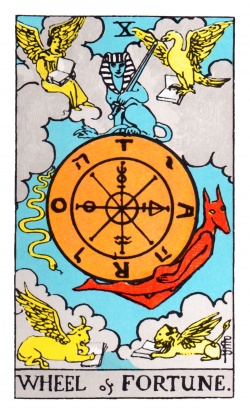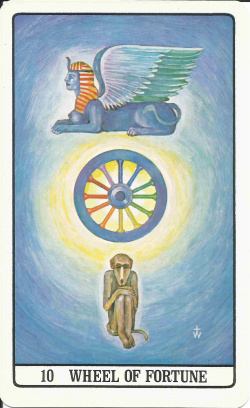The Wheel of Fortune: Difference between revisions
An Avatar.Global Resource
No edit summary |
|||
| (4 intermediate revisions by 2 users not shown) | |||
| Line 12: | Line 12: | ||
[[Old Energy Archetypes]] > {{#ask:[[Is a related term::Old Energy Archetypes]]}} | [[Old Energy Archetypes]] > {{#ask:[[Is a related term::Old Energy Archetypes]]}} | ||
[[The Wheel]] | |||
==Notes== | ==Notes== | ||
| Line 22: | Line 24: | ||
===[[Book of Power]]=== | ===[[Book of Power]]=== | ||
Visually, the Golden Dawn Wheel card inscribes the | Visually, the Golden Dawn Wheel card inscribes the [[Accumulating Class]]<nowiki/>es view of peasants, labourers, indigenous peoples (and others who come under imperial control) as "not fully human, or not human at all..." a view which "enabled distance to be maintained and justified various policies of either extermination or domestication. This is true of 20th century Spanish landlords who held to the "common among the rural upper classes, that the landless labourers were sub-human."<ref>Preston, Paul. ''The Spanish Holocaust: Inquisition and Extermination in Twentieth-Century Spain''. New York: Harper Press, 2012.</ref> Some indigenous peoples ('not human'), were hunted and killed like vermin, others ('partially human'), were rounded up and put in reserves like creatures to be broken in, branded and put to work." <ref>Smith, Linda Tuhiwai. Decolonizing Methodologies: Research and Indigenous People. London: Zed Books, 2012. p. 48).</ref> | ||
Papus emphasizes BALANCE, "command," "supremacy." "The wheel of fortune suspended upon its axis. To the right Anubis, the genius of good ascending; to the left Typhon, the genius of evil descending, the Sphinx is balanced upon the centre of the wheel, holding a sword in its lion claws."<ref>Papus, The Tarot of the Bohemians (Wilshire Book Co, 1978), https://sacred-texts.com/tarot/tob/index.htm.</ref> | Papus emphasizes BALANCE, "command," "supremacy." "The wheel of fortune suspended upon its axis. To the right Anubis, the genius of good ascending; to the left Typhon, the genius of evil descending, the Sphinx is balanced upon the centre of the wheel, holding a sword in its lion claws."<ref>Papus, The Tarot of the Bohemians (Wilshire Book Co, 1978), https://sacred-texts.com/tarot/tob/index.htm.</ref> | ||
| Line 60: | Line 62: | ||
{{endstuff}} | {{endstuff}} | ||
[[category:terms]][[Is an::Old Energy Archetype| ]][Is related to::Fool in School| ]][[Is related to::Judge and Punish/Reward| ]][[Is related to::Excuse and Justification| ]][[Is related to::Good versus Evil| ]] | [[category:terms]] | ||
[[Is an::Old Energy Archetype| ]] | |||
[[Is related to::Fool in School| ]] | |||
[[Is related to::Judge and Punish/Reward| ]] | |||
[[Is related to::Excuse and Justification| ]] | |||
[[Is related to::Good versus Evil| ]] | |||
[[Is a related term::The Wheel| ]] | |||
| | |||
Latest revision as of 16:24, 12 January 2023
The Wheel of Fortune
The Wheel of Fortune is an Old Energy Archetype from the Masonic Tarot Deck. In the Book of Slavery and Book of Power, the archetype is used to reinforce class hierarchies, power, and authority, and also the idea that there should be a "balance" between good and evil.

List of Old Energy Archetypes from the Masonic Tarot
Chariot, Death (archetype), Duality, Hermit, Hierophant, High Priestess, Judgement, Justice, Star, Strength, Sun (archetype), Temperance, The Devil, The Emperor, The Empress, The Fool, The Hanged Man, The Lovers, The Magician, The Moon, The Tower, The Wheel of Fortune, The World (old energy)
Related Terms
Notes

The Wheel is an archetype in the Masonic Tarot deck. The full character of The Wheel, as envisaged by the ruling classes, is provided by the Golden Dawn tarot card which shows a lordly elite (with roots/bloodline in ancient Egypt) lording it over the ape like and primitive slave.
Creation Template: Paul Foster Case intimates the wheel represents Creation Template "The wheel is the symbol of the whole cycle of cosmic expression, and also the emblem of any particular series of events. Its center, or pivot, is the archetypal world; the inner circle is the creative; the middle circle the formative; the outer circle the material world."[1]
Book of Power
Visually, the Golden Dawn Wheel card inscribes the Accumulating Classes view of peasants, labourers, indigenous peoples (and others who come under imperial control) as "not fully human, or not human at all..." a view which "enabled distance to be maintained and justified various policies of either extermination or domestication. This is true of 20th century Spanish landlords who held to the "common among the rural upper classes, that the landless labourers were sub-human."[2] Some indigenous peoples ('not human'), were hunted and killed like vermin, others ('partially human'), were rounded up and put in reserves like creatures to be broken in, branded and put to work." [3]
Papus emphasizes BALANCE, "command," "supremacy." "The wheel of fortune suspended upon its axis. To the right Anubis, the genius of good ascending; to the left Typhon, the genius of evil descending, the Sphinx is balanced upon the centre of the wheel, holding a sword in its lion claws."[4]
"(The Wheel of fortune; the Apprentice displaying his initiative.) In the centre of himself, the Initiate perceives the Warm Hearth which corresponds to the column of ]: his wages as Apprentice are expressed in an energy of which he has an inner source, that makes him undertake tasks with daring, but never without regard to fitness....the Mason sets to his task when the time has come for the work to be started."[5] p. 171.
Self-referential. Used to bolster the supposed authority of the tarot. "ROTA TARO ORAT TORA ATOR, which may be translated thus: (The) WHEEL, TARO, SPEAKS (the) LAW (of) HATHOR." [6]
Dialectical "mixing" "It is the revolution of experience and progress, the steps of the Zodiac, the revolving staircase, held in place by the changing influence of Light and Darkness..." [7]
Conciliation: " Conciliation implies concord, agreement, sympathy, peace, amity, and tranquility. The law here shown is that which reconciles apparent differences, which enables us to harmonize the elements of existence, which leads to the winning over of seemingly antagonistic forces, which conduces to peace and prosperity."[8]
"Conciliation is the adjustment of differences, the establishment of harmony and order, and thus is distinctly Jovian. The mode of consciousness here indicated is also that which brings perception of the law which fulfills the promise, "Seek, and ye shall find." Conciliation implies concord, agreement, sympathy, peace, amity, and tranquility. The law here shown is that which reconciles apparent differences, which enables us to harmonize the elements of existence, which leads to the winning over of seemingly antagonistic forces, which conduces to peace and prosperity"[9]
"The idea of Command, of Supremacy."[10]
Book of Slavery
Excuse and justification: "In Thomas Malory's version of the King Arthur story we find the suggestion that the Wheel symbolizes the random turnings of 'luck'. Why do some people get rich and others poor? Why should a powerful king fall, and a formerly weak one rise to power? Who, or what, controls the turning wheel of life? Malory suggests that luck, seemingly meaningless ups and downs, is in reality fate; that is, the destiny God has chosen for each individual, based on reasons only God can understand." [11] Things happen because of spirit, but for reasons we do not always understand.
"...we find that fate is also an illusion, a dodge to cover up the fact that we, with our limited vision, cannot see the inner connection between all things. 'Oh well,' we say, 'it's fate', a meaningless statement because we cannot understand the meaning. Things do not just happen, they are made to happen. The power to shape events, to give life and form and purpose to the universe, belongs, Malory tells us, to the Holy Ghost, dwelling in the physical world as a presence within the Holy Grail (the Ace of Cups) in the same way that the Shekinah physically dwelt within the veiled sanctuary of the temple at Jerusalem."[12]
The acceptance of evil: "The wheel of fortune suspended upon its axis. To the right Anubis, the genius of good ascending; to the left Typhon, the genius of evil descending, the Sphinx is balanced upon the centre of the wheel, holding a sword in its lion claws."[13]
"It is the revolution of experience and progress, the steps of the Zodiac, the revolving staircase, held in place by the counter changing influence of Light and Darkness..."[14]
"The undulating serpent of knowledge suggests that life's ups and downs bring the potential of knowing your Self more fully. The jackal-headed guardian of the underworld, Anubis, on whom the wheel seems to rest, reminds you that although dark times are a natural part of the life cycle, divinity is always traveling with you."[15]
"Wheel of Fortune is the karma card. It can represent a turning point in the Seeker’s life. Movement is coming. What goes up will come down. What hits bottom will bounce up. Forces are in motion. There may be a turn of luck. The card could represent a force majeure coming in the Seeker’s life. An “act of god,” chance occurrence, unavoidable accident, or matter beyond the Seeker’s control may happen and affect the outcome of events."[16]
Judge and Punish: "The ever-turning Wheel of Life came to signify the laws of karma, leading you to reincarnate in one body after another. Now, karma is in a way simply another explanation for the mystery of fate. By the actions you take in one life, you build up a certain destiny for yourself in the next, so that if you commit a great many evil deeds you create in your immortal self a kind of psychic need for punishment. When the time comes for your next incarnation you inevitably choose a low caste or diseased body. (This simple psychological explanation of karma is perhaps based more on Buddhism than Hinduism.)[17]
NEOLIBERAL: Individual aspiration and hard work "The Psychological Mode of Action that this card expresses is someone who is a constant striver, not the fanatic, but someone whose growth potential is consistent with these abilities."[18]
Citation and Legal
Treat the SpiritWiki as an open-access online monograph or structured textbook. You may freely use information in the SpiritWiki; however, attribution, citation, and/or direct linking are ethically required.
Footnotes
- ↑ Case, Paul Foster. Learning Tarot Essentials: Tarot Cards for Beginners. Vancouver: Ishtar Publishing, 1932. p. 106/
- ↑ Preston, Paul. The Spanish Holocaust: Inquisition and Extermination in Twentieth-Century Spain. New York: Harper Press, 2012.
- ↑ Smith, Linda Tuhiwai. Decolonizing Methodologies: Research and Indigenous People. London: Zed Books, 2012. p. 48).
- ↑ Papus, The Tarot of the Bohemians (Wilshire Book Co, 1978), https://sacred-texts.com/tarot/tob/index.htm.
- ↑ Wirth, Oswald. Tarot of the Magicians: The Occult Symbols of the Major Arcana That Inspired Modern Tarot. San Francisco. CA: Weiser Books, 1990.
- ↑ Case, Paul Foster. An Introduction to the Study of the Tarot. New York: Kindle Edition, 1920.
- ↑ Wang, Robert. An Introduction to the Golden Dawn Tarot. Main: Sam Weiser, 1978. p. 139.
- ↑ Case, Paul Foster. Learning Tarot Essentials: Tarot Cards for Beginners. Vancouver: Ishtar Publishing, 1932. p. 104
- ↑ Case, Paul Foster. An Introduction to the Study of the Tarot. New York: Kindle Edition, 1920. p. 104.
- ↑ Papus. The Tarot of the Bohemians. Wilshire Book Co, 1978. https://sacred-texts.com/tarot/tob/index.htm. p. 119
- ↑ Pollack, Rachel. Seventy-Eight Degrees of Wisdom. Harper Collins, 1980. p. 84.
- ↑ Pollack, Rachel. Seventy-Eight Degrees of Wisdom. Harper Collins, 1980. p. 85-6.
- ↑ Papus. The Tarot of the Bohemians. Wilshire Book Co, 1978. https://sacred-texts.com/tarot/tob/index.htm. p. 119
- ↑ Wang, Robert. An Introduction to the Golden Dawn Tarot. Main: Sam Weiser, 1978. p. 138-9
- ↑ Jayanti, Amber. Tarot for Dummies. New York: Hungry Minds, 2002. p. 93.
- ↑ Wen, Benebell. Holistic Tarot: An Integrative Approach to Using Tarot for Personal Growth. Berkeley, CA: North Atlantic Books, 2015.
- ↑ Pollack, Rachel. Seventy-Eight Degrees of Wisdom. Harper Collins, 1980. p. 85-6.
- ↑ Zalewski and Zalewski, The Magical Tarot of the Golden Dawn, p. 130.
